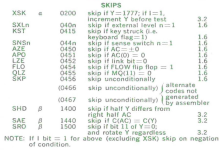BitWiz
Veteran Member
Comparing the May 1969 copy that i have to the January 1970 produced the following differences:
Page 2:
1970 has two additional instructions:
SWD
STB
1970 shows the SXL instruction as 040N, 1969 shows it as 0400
1970 shows the SKP instruction as 0467, 1969 shows it as 0446
1970 shows the IOB instruction as execute PDP-8 I/O instruction, 1969 shows it as execute I/O operation
Page 3
1970 shows the LDF instruction as 064n Set Data Field n, 1969 shows it as 0640 Set Data Field
1970 shows the LIF instruction as 060n Set Instruction Field n, 1969 shows it as 0600 Set Instruction Field
1969 has 1900 as an undefined trapped instruction that is not on the 1970
1969 has 1717 as an undefined trapped instruction
1970 lists 1700 through 1737 as undefined trapped instructions
Page 5
1970 shows I=1 ß=0 operand is in next location 1969 shows address is in next location
Page 11
1970 shows 15 Bit Absolute Octal Address, 1969 shows 15 Bit (Address)-8
Page 12 (back page)
1970 shows @ and Bell that 1969 does not.
Page 2:
1970 has two additional instructions:
SWD
STB
1970 shows the SXL instruction as 040N, 1969 shows it as 0400
1970 shows the SKP instruction as 0467, 1969 shows it as 0446
1970 shows the IOB instruction as execute PDP-8 I/O instruction, 1969 shows it as execute I/O operation
Page 3
1970 shows the LDF instruction as 064n Set Data Field n, 1969 shows it as 0640 Set Data Field
1970 shows the LIF instruction as 060n Set Instruction Field n, 1969 shows it as 0600 Set Instruction Field
1969 has 1900 as an undefined trapped instruction that is not on the 1970
1969 has 1717 as an undefined trapped instruction
1970 lists 1700 through 1737 as undefined trapped instructions
Page 5
1970 shows I=1 ß=0 operand is in next location 1969 shows address is in next location
Page 11
1970 shows 15 Bit Absolute Octal Address, 1969 shows 15 Bit (Address)-8
Page 12 (back page)
1970 shows @ and Bell that 1969 does not.

